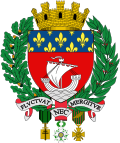


| History of Paris |
|---|
 |
| See also |
|
|
First Consul Napoleon Bonaparte moved into the Tuileries Palace on 19 February 1800 and immediately began to re-establish calm and order after the years of uncertainty and terror of the Revolution. He made peace with the Catholic Church; masses were held again in the Cathedral of Notre Dame, priests were allowed to wear ecclesiastical clothing again, and churches to ring their bells.[1] To re-establish order in the unruly city, he abolished the elected position of the Mayor of Paris, and replaced it with a Prefect of the Seine and a Prefect of Police, both appointed by him. Each of the twelve arrondissements had its own mayor, but their power was limited to enforcing the decrees of Napoleon's ministers.[2]
After he crowned himself Emperor on December 2, 1804, Napoleon began a series of projects to make Paris into an imperial capital to rival ancient Rome. He built monuments to French military glory, including the Arc de Triomphe du Carrousel, the column in Place Vendôme, and the future church of the Madeleine, intended as a temple to military heroes; and began the Arc de Triomphe. To improve the circulation of traffic in central Paris, he built a wide new street, Rue de Rivoli, from the Place de la Concorde to the Place des Pyramides. He made important improvements to the city's sewers and water supply, including a canal from the Ourcq River, and the construction of a dozen new fountains, including the Fontaine du Palmier on Place du Châtelet; and three new bridges; the Pont d'Iéna, Pont d'Austerlitz, including the Pont des Arts (1804), the first iron bridge in Paris. The Louvre became the Napoleon Museum, in a wing of the former palace, displaying many works of art he brought back from his military campaigns in Italy, Austria, Holland and Spain; and he militarized and re-organized the Grandes écoles, to train engineers and administrators.
Between 1801 and 1811, the population of Paris grew from 546,856 to 622,636, nearly the population before the French Revolution, and by 1817 it reached 713,966. During Napoleon's reign, Paris suffered from war and blockade, but retained its position as a European capital of fashion, art, science, education, and commerce. After his downfall in 1814, the city was occupied by the Prussian, English and German armies. The symbols of the monarchy were restored, but most of Napoleon's monuments and some of his new institutions, including the form of city government, the fire department, and the modernized Grandes écoles, survived.
- ^ Héron de Villefosse, René, Histoire de Paris, p. 299
- ^ Combeau 1999.